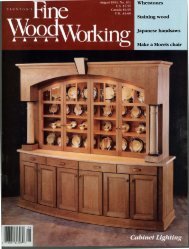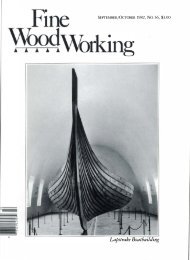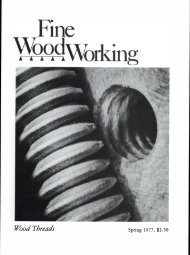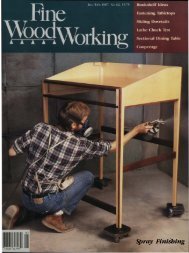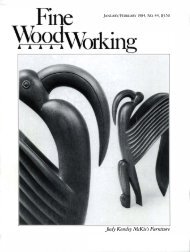NOVEMBER/DECEMBER 1983, No. 43, $3.50 Making ... - Wood Tools
NOVEMBER/DECEMBER 1983, No. 43, $3.50 Making ... - Wood Tools
NOVEMBER/DECEMBER 1983, No. 43, $3.50 Making ... - Wood Tools
Create successful ePaper yourself
Turn your PDF publications into a flip-book with our unique Google optimized e-Paper software.
57 Fig. 2: The five parts of a tote Overall length of<br />
bow is in.<br />
Bow<br />
Bore angled<br />
mortises for leg s, .<br />
40<br />
Ease edges with<br />
a spokeshave.<br />
Fig. 3: Bending form<br />
While the bow dries,<br />
hold its shape with twine.<br />
Bend nails to hold legs.<br />
l...<br />
Bow section 4 V2 finished size<br />
at foot end<br />
12<br />
Taper.<br />
16-in.<br />
kerf<br />
for leg<br />
bends<br />
I II<br />
I,<br />
T ., 1<br />
are following the grain. If it goes tic, tic and gives a little at a<br />
time, you're on. When it sounds like a branch breaking, it's<br />
jumping the grain and you need to sttaighten it out.<br />
Make your rough splits X in. oversize in section; you'll be<br />
shaving them down to finished dimensions with the drawknife.<br />
The bow will be steam-bent later, so keep grain direction<br />
in mind. Whether the growth rings are radial or tangential<br />
to the bend is up to you. I prefer a tangential split-it<br />
looks nicer and it makes it easier to follow the grain.<br />
Drawknifmg to size-<strong>No</strong>w the pleasant work can begin.<br />
Clamp the bow in your horse and shave one face smooth with<br />
the drawknife. Shave with the grain as much as you can and<br />
watch for tearing. You may not be able to read the grain, but<br />
your drawknife will. Downhill, the cut will be deliciously<br />
smooth; uphill, the knife will dig in. Pull in long, even<br />
strokes, sliding the drawknife sideways as you go. If you're<br />
doing it right, the slicing motion will peel off long shavings of<br />
even thickness. On each piece, smooth one face first, then<br />
square up an adjacent edge and shave the opposite face and<br />
edge to yield the finished dimensions. It's the same order of<br />
cuts you'd follow using a jointer, tablesaw and thickness<br />
planer. Keep the rails in a cool, damp spot so that they'll<br />
retain enough moisture to swell the tenons later. Dry the<br />
stretchers and the bow over a woodstove.<br />
Define the handle's shape with graceful, Ys-in. radius scallops<br />
on each side. By using the drawknife with the bevel<br />
down, you can control the depth and the shape of the scallop.<br />
Otherwise, the knife will want to dig in. Starting about 12 in.<br />
from each end of the bow, drawknife a taper toward the handle,<br />
as shown in figure<br />
19<br />
2. Also, hollow the inside (compression<br />
side) of the bow a little, maybe 'li6 in. at the handle<br />
tapering to zero about in. from each end.<br />
Shape the handle to your liking, then ease the edges of the<br />
bow, rails and stretchers with your spokeshave. Finally, with a<br />
I handsaw or bandsaw, rip 16-in. long kerfs at each end of the<br />
bow so that it can be wish boned into the rails after steaming.<br />
My steamer is a stainless steel tube capped at one end, half<br />
filled with water and placed in the firebox of my woodstove.<br />
Any steel pipe or even an old steel drum will work. While the<br />
bow steams, make up the simple bending form shown in figure<br />
3. It should be constructed to overbend the leg splits a<br />
little so that they'll have to be sprung back in to fit into the<br />
rails. This tension will stop the legs from splitting further.<br />
With gloved hands, remove the bow from the steamer and<br />
limber up the bends by forming them over your knee. First<br />
put bends on each side of the handle about 4 in. from the<br />
center. This creates a bow with two "shoulders" rather than<br />
one that's a perfect half-circle. After you've defined the shoulders,<br />
bend the bow like Superman would bend a bar of steel.<br />
Make adjustments where needed-the handle has to look<br />
right, and you can't change the bend when it's in the form.<br />
To keep the wood from splitting as you limber the leg<br />
bends, clamp the top of the kerf in your shaving horse and<br />
flex the legs into a graceful sweep from a point 1'l;; in. below<br />
the end of the kerf. Watch for kinks. A couple of turns of<br />
twine at the end of the kerf will keep the split from advancing<br />
when you release it from the shaving horse. Put the bow<br />
in the form and pull its sides in with a twine wrap.<br />
Assembling the carrier-I assemble the stretchers to the rails<br />
after first whittling %-in. long by ;.{6-in. diameter tenons at



